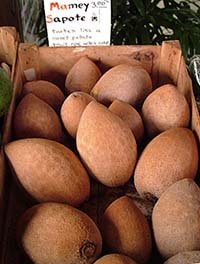Selection and storage
Several cultivars of mamey sapote hit the market all round the season. Normally, they are imported into the US. Harvesting is usually done manually by gently plucking/cutting with clippers.
Only mature fruits continue to ripen after their harvest and become edible. Therefore, their maturity is adjudged by scratching the fruit’s surface to make sure whether the skin is ”not green” underneath the scruff.
 |
| Sapota fruits. Note for rusty gray raw fruits. (Photo courtesy by Mark) |
In the markets, buy fresh mamey with smooth, intact skin and without surface cuts/cracks, bruises, or wrinkles. Once ripened, the fruit just yields to gentle thumb pressure.
As in other Sapotaceae members, mamey too must be kept at room temperature for 4 to 7 days to ripen. The firm, ripe fruits can keep well for several days in the home refrigerator and if set at 35° F, they can last for a few weeks.
Preparation and serving method
Only ripe mamey sapote is fit for consumption. Cut the fruit lengthwise into halves using a paring knife, then scoop the flesh using a spoon and discard its seed. It should be enjoyed without any additions in order to experience its unique flavor.
Here are some serving tips:
-
Fresh mamey sections are a great addition to fruit salads.
-
Mamey sapote milkshake/smoothie is a favorite drink.
-
It is also used in ice creams, jams, jellies, preserves, cakes, pies, etc.
Safety profile
Being one of the members in the Sapotaceae family of tropical fruits, mamey sapote features milky sap from its leaves and immature fruits.
The sap is composed of astringent compounds like tannins. These compounds are particularly concentrated in the raw mamey fruits which gives them an intensely bitter taste.
Consumption of raw, unripe mamey could result in raw sensation in the mouth and throat, mouth ulcers, swelling of throat mucosa, and breathing difficulty, especially in children.
(Medical disclaimer).
≻≻-Back to Sapodilla (sapota).
≻≻-Back to Fruits from Mamey sapote. Visit here for an impressive list of all varieties of fruits with
complete illustrations of their nutrition facts and health benefits.
≻≻-Back to Home page.
Further Resources:

